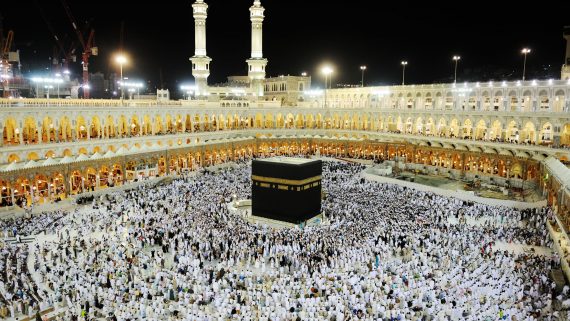At present, it is estimated that there are between 4.000 and 5.000 different religions around the world, although it is not possible to give an exact figure. However, we do know which religions are with the most followers:
| Religion | Approximate number of followers |
| Christianity | 2.100.000.000 |
| Islam | 1.155.000.000 |
| Hinduism | 1.010.000.000 |
| Budismo | 776.000.000 |
| Traditional chinese religion | 394.000.000 |
Below you have an index with all the points that we are going to deal with in this article.
Article Index
- 1.
- 2.
- 3.
- 4.
- 5.
Christianity
From Latin christianismus, Christianity has its historical origin in the Judaism of the beginning of the present era. This is because Jesus of Nazareth, the greatest exponent of the Christian religion, always identified himself as a devout Jew, both in his doctrine and in his teachings.
This monotheistic Abrahamic religion is based on the life of the same, which is collected in the Biblia.
The set of canonical books of Judaism and Christianity are collected in the Bible or holy book, whose purpose is none other than to transmit the word of God. Currently, the Bible has been translated into 2.454 languages.
The Bible itself is a compilation of texts that were written in Hebrew, Greek and Aramaic in the first place, and that were later put together to form the Jewish Tanakh or Old Testament for Christians and, later, the New Testament.
While the Old Testament tells the story of the Hebrew people, the New Testament deals with the life, death, and resurrection of Jesus, as well as the message he conveyed and the history of the first Christians.
Ultimately, the Bible is a spiritual work that for believers constitutes the way in which God revealed himself and manifested his will for the salvation of Humanity.
It is worth mentioning that, throughout its history, Christianity has gone through numerous divisions, which have given rise to various groups of beliefs with consequent variations depending on the place and culture that surrounds them.
Since the Protestant Reformation (XNUMXth century), this religion has been divided into three main branches, which predominate in the following areas and countries of the world:
- Catholics: Southeastern Europe, North and Central Africa, South America, Mexico, Canada and the Philippines.
- Protestants: Nordic countries, United Kingdom, Australia, South Africa, Namibia, Botswana, United States of America and Greenland.
- Orthodox: Russia and Ukraine.
The main Christian belief is that which dictates doctrine of the Trinity: God is one and, at the same time, Father, Son and Holy Spirit. He is the creator and responsible for preserving the universe and caring for mankind through his Word.
What he looks for in the human being is the performance of good works. In general, Jesus Christ is the Messiah described in the Old and New Testaments, and at the same time he is fully God and human at the same time.
Another of the main doctrines of Christianity is that of salvation through conversion and forgiveness of sins, which results in victory over all the consequences of sin.
Salvation can be granted by the grace of God and is what Jesus Christ achieved in his crucifixion and subsequent resurrection. If God grants salvation, eternal life is obtained, hence the ascension of Jesus Christ to heaven, that is, the Kingdom of God dictated by the Bible.
The practices carried out by Christians involve the establishment of a relationship with God.
Therefore, to be a good Christian, the seven sacraments must be fulfilled (in chronological order): baptism (introduction of the person to Christianity), confirmation, Eucharist, penance, priestly order, marriage and anointing of the sick.
Islam
Islam is a monotheistic religion based on the holy book of the Quran, whose fundamental premise for its adherents is that "There is no God but Allah" and, in turn, Muhammad is the last messenger of Allah (in Arabic, Allah, Meaning God).
Followers of Islam are called Muslims, term from Arabic muslim which literally means who submits, and its official language is Arabic.
The main countries where Islamism is practiced are Saudi Arabia, Somalia and Afghanistan, whose percentage of Muslim population is close to 100%. 98-99% of the population of countries such as the Maldives, Western Sahara, Turkey, Iran, Algeria, Mauritania and Yemen is also estimated to be followers of this religion.
Islam is not only a religion, but a culture in which aspects such as social, family, educational and judicial life, and even the way of dressing are governed by the guidelines set by religion.
This means that the commandments of the Koran are those that govern the functioning of the State, that is, the law that governs society. In this way, the Constitution of Muslims is called Sharia or Islamic law, where the rights and duties of man, penalties, crimes ...
Muslims have three holy places, which are listed below:
- Mecca: it is the city to which Muslims must make pilgrimage at least once in their life. In it Muhammad was born and it is where the Masjid al-Haram mosque is located (literally, holy mosque), in which praying involves obtaining a reward equivalent to 100.000 prayers.
- Medina: It is the place that saw the prophet Muhammad arrive when he emigrated to Mecca, gave him refuge and accepted his message. Its inhabitants were then known as the "Ansar" for having welcomed it. There he died and was buried too.
- Al-Aqsa Mosque: Muslim tradition tells that this mosque located in Jerusalem is the place where Muhammad ascended to heaven. Praying in the Al-Aqsa Mosque is equivalent to the reward of 500 prayers, since it is considered as the place where Muhammad communicated with God and prayer was established.
For Islam, each member of society has a set of rights and duties, so every individual who accepts this religion must guide his life according to these rules.
These rights are included in the Risalatul Huquq, which includes the Right of God, the Rights of the language, the Rights of women and the Rights of the enemy, among many others.
However, in general, the law of Islam imposes four types of rights and duties on man:
- Duties towards God: every man is obliged to fulfill them. According to the Qur'an, man must constantly reflect and remember God, as well as obey him, accept his will and be aware at all times that his function on Earth is to worship and please one God.
- Duties of man with respect to himself: The Koran dictates that God does not change the situation of a people or society, but that it is the individuals that compose it who change what is in themselves, that is, body, mind and soul.
- Rights of others with him: the family, parents, marriage and community are its four great pillars. Maintaining kinship ties and pleasing parents are two principles linked to pleasing God. Within marriage, there are obligations of the husband with respect to the wife and vice versa, as well as obligations and rights of the children.
Hinduism
Is named hinduist to any person who practices any of the religions of Hinduism and is part of that same culture. It is a religion that lacks a founder, since it actually encompasses several different religions, which are erroneously called the same way.
Hinduism is the majority religious tradition in Bali, Nepal, India, and the African island of Mauritius. India specifically is the cradle of Hinduism and is considered its holy land, where 80,5% of the population profess it.
However, there are significant Hindu immigrant communities in countries such as Saudi Arabia, Burma, Indonesia, Mexico, Panama, South Africa, and Thailand. In western countries such as the United Kingdom and the United States, there are equally important groups of Hindus.
Hinduism has two sacred texts Main:
- Shruti: consists of a group of sacred texts that can only be followed to the letter. On the one hand, it encompasses all four Vedas and, on the other hand, Upanishad.
- smiriti: the term means remembered o the tradition. In this group of sacred texts are included the epic text Mahabharata, the Ramaiana or epic story of the god-king Rama, the 18 main Puranas and the ancient texts on ayurveda (traditional Hindu medicine).
The basis of all Hinduism is governed around the reality called Brahman or inner essence, that is, the idea that the set of all things and events that surround us are nothing more than different manifestations of the ultimate reality.
Si Brahman refers to an intangible and incomprehensible sphere for the individual of the earthly world, its manifestation in the human soul is called Atman. The idea that Brahman and Atman merge into one is the essence of Upanishad previously mentioned.
It is important to emphasize the fact that Hinduism does not mean a religion or a philosophy, but rather a large and complex socio-religious organism, where there is room for endless ceremonies, rituals, disciplines and gods.
For Hinduism, the world works through God's self-sacrifice, where the term sacrifice is used in the sense of make sacred. Thus, it implies the fact that God transforms himself into a world that eventually ends up becoming God, and so on constantly. This activity is called lilac.
The Hindu Pantheon has a multitude of gods, although there are three of the most relevant:
- roar: He is the creator god of the universe and is usually represented with 4 heads and 4 arms, each of them holding the 4 Vedas, and leaning on a goose. The continuation of life will only be possible if Brama remains awake; when he sleeps, everything dies except the gods. The Brahma temple in Pushkar (India) is dedicated to him.
- Vishnu: it is represented with 4 arms that hold a mallet (symbol of power), a lotus flower (symbol of creation and life), a cog wheel (weapon that makes it invincible) and a conch (the sound when blowing through it symbolizes the origin of the universe). He is the most popular God of India and is considered to have already completed 9 of the 10 reincarnations that must take place, the tenth in the form of the warrior Kalki.
- Shiva: He is the god in charge of destruction, but not in a cruel and ruthless sense, but in order to allow everything to be created anew. In fact, the only time Brahma can sleep for a day is when Shiva destroys the universe to create it anew and thus start a new cycle.
Budismo
Buddhism is at the same time non-theistic religious doctrine and philosophical current belonging to the Dharmic family, a term from Sanskrit dharma, whose meaning is religion o religious law.
The Buddhist religion was founded by Gautama Buddha in India during the XNUMXth century BC. Since then, it has evolved, leading to the creation of a wide range of schools and practices.
In early Buddhism, the life and doctrine of Gautama were transmitted orally until they were first compiled into the Pali or Tipitaka Canon, the first written compilation of Buddhism, although a full biographical compilation was not developed until several centuries later. specifically in the XNUMXst century AD at the hands of the Hindu master Aśvaghoṣa.
The life stories of Gautama Buddha are not just a biographical data set, but a guide to the lives of his followers.
Buddhism encompasses a series of fundamentals that constitute the basis of Buddhist teachings. Although there is a wide range of schools and manifestations, Buddhists share a number of common philosophical principles and concepts:
- The Four Noble Truths: 1) life includes duḥkha, that is to say, suffering, dissatisfaction or discontent; 2) the origin of duḥkha is tṛṣṇā or longing; 3) suffering or duḥkha it can be extinguished if its cause is known; 4) once the cause is found, the method for its extinction is the Noble Eightfold Path, which includes wisdom, cultivation of mind and heart, and ethical conduct.
- The Three Characteristics of Existence (Tri-laksana) - this principle explains the nature of the phenomena of the perceived world, which is composed of three universal characteristics: Anitya or impermanence, anatman or nonexistence of a permanent ego and duḥkha or suffering.
- Karma: its meaning in Sanskrit is causality o law of cause and effect. Karma would be all intentional action, since one or more effects that appear when circumstances are prone are derived from it. The "good" or "bad" karma are distinguished according to the origin of the actions.
- Conditioned emergence (pratītya-samutpāda): it is a very elaborate formulation that refers to the process of existing and how individuals are trapped in a cycle of suffering and, therefore, in ignorance. This cycle covers several links from the avidya or ignorance until jarā-maraņa or death, and implies the fact that "being" is a realm that is created and destroyed moment after moment.
- Renacimiento: It should be noted that the principle of rebirth is not equivalent to the concept of reincarnation present in Hinduism. For Buddhism, rebirth is not viewed as desirable or equated with a destiny of being. The path to rebirth supposes that the being is liberating itself from karma or chain of causes and effects over time.
- Samsara fleetAlthough it is an existing concept in Hinduism and other philosophical traditions, for Buddhists it corresponds to the suffering of the material world. The human being must learn to liberate himself from samsara to achieve nirvana, but this depends on spiritual practices and karma accumulated in previous lives.
- Nirvana: nirvana or nirvana it is the awakening, the illumination of being. When the individual reaches this state, it means that he has achieved spiritual liberation from the duḥkha or suffering and the cycle of rebirths. In short, it is a state of supreme happiness.
Buddhism is the predominant religion in China, Mongolia and Japan, although historically it was considered the majority religion in all Asia. The large number of countries and regions that Buddhism has passed through throughout its historical journey has made it a religion where there is room for endless approaches.
It is one of the largest religions in the world after Christianity, Islam and Hinduism, and in turn above the traditional Chinese religion. About 6% of the world's population today is Buddhist.
Traditional Chinese religion and Taoism
Traditional Chinese religion is more of a religious tradition in which public authorities and ordinary citizens share a number of religious practices and beliefs. These range from the veneration of the forces of nature and ancestors to the exorcism of harmful or noxious forces.
Here are the main concepts of traditional Chinese religion and Taoism:
- Tian: this word means day o sky in Chinese and constitutes the absolute principle of universal reality. He Tian it is a transcendental and immanent reality.
- Yin and yang: these are two concepts of Taoism that refer to the duality of all things present in the universe, that is, two opposite and complementary forces. According to this principle, each thought, being or object has a complement on which it depends to exist, which, in turn, exists within itself.
- Hun y po: These are the names that Chinese philosophy has given to two different types of souls, thus forming a dualism according to which every human being has a spiritual and ethereal part (have an updated ), at the same time as a corporeal soul that remains in the body of the deceased (po).
- Bao ying y yun ming: the first concept can be translated as reciprocity and, according to him, all manifestations of being have a limited time of life and a predetermined destination. For his part, yun ming it refers to the fact that nothing we can see is chance, but that everything is part of the rhythm of our destiny, which was already established prior to the appearance of a certain event.
- Ling y xian ling: the idea of ling refers, on the one hand, to the sacred and, on the other, to supernatural power. The term Shen is used synonymously in the sense of spiritual. Bill xian ling refers to the manifestation of a god in a specific place or in a temple.
Although with some variations, 30% of the Chinese population is followers of the traditional Chinese religion. In Taiwan, however, it has been incorporated into the set of beliefs typical of Taoism, which constitutes the religion of 33% of the population. It is also present in 3% of the Malay population.
For its part, Taoism constitutes rather a philosophy of life that is fundamentally based on the Tao Te King attributed to the Chinese philosopher Lao Tse. The main teaching of Taoism refers to the concept of Tao, which is an absolute and at the same time mutable unit that governs the cosmological and ontological principle of all things.
We have included Taoism in the same section as traditional Chinese religion because the truth is that the latter has inherited the basic principles and the spiritual doctrine of Taoism, as well as Buddhism and Confucianism, which causes several saints to share.
This article has been shared 330 times. We have spent many hours collecting this information. If you liked it, share it, please:



























